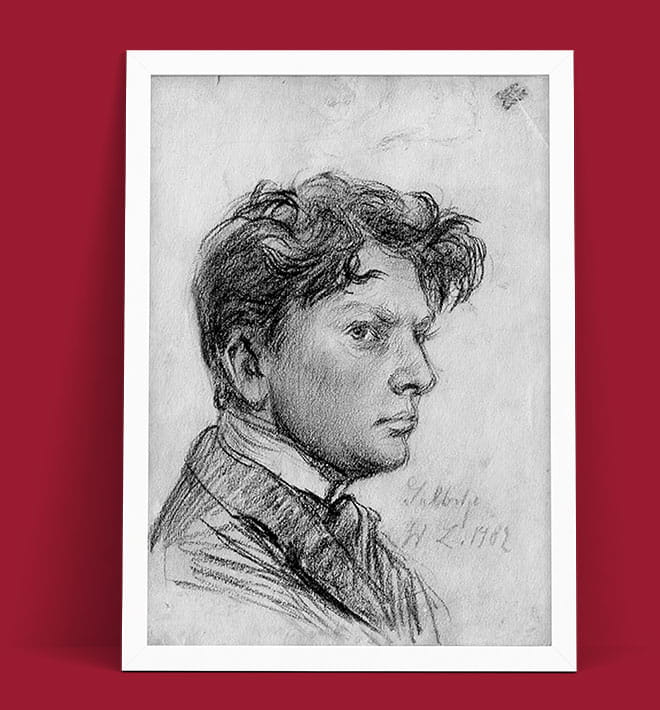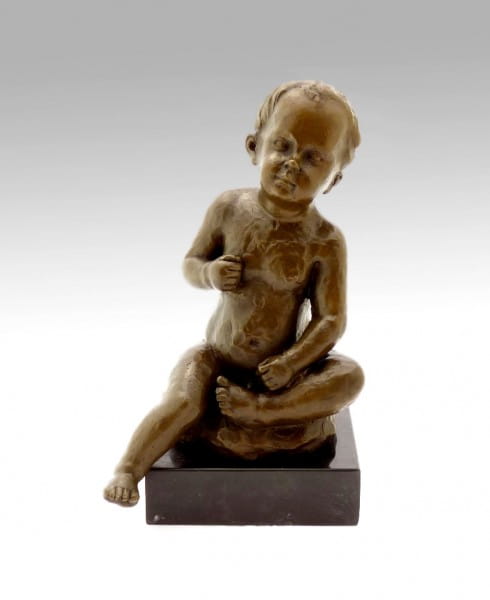Prices incl. VAT, free shipping worldwide
Ready to ship today,
Delivery time appr. 3-6 workdays










Product description
"Wilhelm Lehmbruck - Sitting Boy - signed 1910 - Bronze"
| Weight | 6 kg |
Wilhelm Lehmbruck’s “Sitting Boy” – A Timeless Reflection in Bronze - Signed
At first glance, the sculpture of the “Sitting Boy” by Wilhelm Lehmbruck radiates an almost meditative silence. Cast in bronze and dating back to 1910, this work is far more than a mere portrait of childhood. It embodies the delicate intersection between physical presence and emotional introspection. The child’s softly tilted head, the loosely crossed legs, and the tender shaping of his small torso evoke a haunting sense of vulnerability and resilience. Every line and curve seems to murmur a story of inward gaze and suspended time—timeless, and yet wholly human.
Birth of a Sculptural Voice in Meiderich
Wilhelm Lehmbruck, born on January 4, 1881, in Meiderich (today a district of Duisburg), emerged as one of the most profound and emotionally resonant sculptors of the early 20th century. Deeply influenced by his working-class upbringing and academic training at the Kunstakademie Düsseldorf, he quickly developed a unique formal language, grounded in both classical beauty and existential contemplation. The “Sitting Boy,” created in 1910 in Paris, reflects a critical moment in Wilhelm Lehmbruck’s career—a period of artistic breakthrough, as he moved away from naturalistic conventions and towards an expression of the soul’s architecture.
The Paris Years and Emotional Clarity
By the time Wilhelm Lehmbruck sculpted the “Sitting Boy,” he had moved to Paris, where the vibrant currents of avant-garde thought permeated his vision. Surrounded by figures like Rodin and Maillol, Lehmbruck embraced the idea that sculpture could go beyond surface to suggest the spiritual. The “Sitting Boy” does exactly that. Though modest in scale, the sculpture communicates an astonishing depth of feeling. Its softened features and organic posture express not only the physical fragility of youth but also an acute awareness of the emotional complexities embedded in human experience.
Form as Silent Language
The “Sitting Boy” reveals Wilhelm Lehmbruck’s remarkable ability to allow form to speak for itself. The sculpture is neither romanticized nor decorative. It avoids sentimentality and instead captures a universal quietness. Lehmbruck understood how to balance anatomical clarity with a longing for transcendence. The boy’s limbs are relaxed, but his inner world is concentrated. The right hand, curled slightly toward the chest, creates a gentle, protective gesture—a gesture which subtly invokes themes of memory, innocence, and introspection, so central to Wilhelm Lehmbruck’s evolving vocabulary.
A Modern Classic Cast in Bronze
Executed in bronze, the material adds gravity and permanence to the ephemeral quality of childhood depicted here. The warm patina absorbs and reflects light, reinforcing the sculpture’s aura of contemplation. In the hands of Wilhelm Lehmbruck, bronze becomes soft, almost flesh-like, rendering the spiritual sensibility of the piece in tactile terms. Unlike many bronze figures of the time, which emphasized grandeur or physical idealization, the “Sitting Boy” offers a celebration of stillness and the hidden grace of the ordinary.
Psychological and Symbolic Dimensions
Far beyond its literal subject, the sculpture suggests a metaphysical landscape. The “Sitting Boy” embodies what Wilhelm Lehmbruck saw as the fundamental human condition—our capacity for suffering, beauty, and solitude. The work can be interpreted as a quiet response to the looming turbulence of the early 20th century. Created just four years before the outbreak of the First World War, the boy’s pensive face and inward posture eerily foreshadow the loss and existential questioning that would soon grip Europe—and tragically, Lehmbruck himself.
Lehmbruck’s Legacy and the Path to Tragedy
The personal life of Wilhelm Lehmbruck was shadowed by melancholy and increasing despair. Despite early recognition and international exhibitions, his psychological struggles grew deeper during the war years. He returned to Germany and took his own life in Berlin on March 25, 1919, at the age of 38. The tragedy of his death makes works like the “Sitting Boy” all the more poignant—lasting testaments to a creative spirit deeply attuned to the fragile threads of life and form. His works continue to remind viewers of the profound emotional truth that sculpture can achieve.
A Global Presence in the World’s Greatest Museums
The enduring resonance of Wilhelm Lehmbruck’s art is evidenced by the inclusion of the “Sitting Boy” and similar works in the collections of major international institutions. The Lehmbruck Museum in Duisburg, built to preserve and celebrate his legacy, holds a central place in the display of his oeuvre. The Städel Museum in Frankfurt am Main exhibits his sculptures as key pieces in German modernism. Internationally, Museum of Modern Art (MoMA), New York continue to present Lehmbruck’s vision to diverse global audiences, underlining the timeless significance of his work.
A Sculptor of the Soul
Ultimately, the “Sitting Boy” by Wilhelm Lehmbruck is not simply a sculpture. It is a moment cast in bronze—a moment of stillness, sensitivity, and silent resilience. It speaks in the language of form, in gestures barely perceived but deeply felt. It encapsulates the existential search that defined Wilhelm Lehmbruck’s life and artistic practice. In an age of noise and motion, it remains a beacon of quiet reflection, as urgent now as it was in 1910.
Height: 34 cm
Width: 19 cm
Depth: 19 cm
Weight: 6 kg
100% Bronze
Our advantages
free shipping
Worldwide free shipping
14 days money back
You can cancel your order
within 14 days
secure payment services
Paypal, Master Card, Visa, American Express and more






















